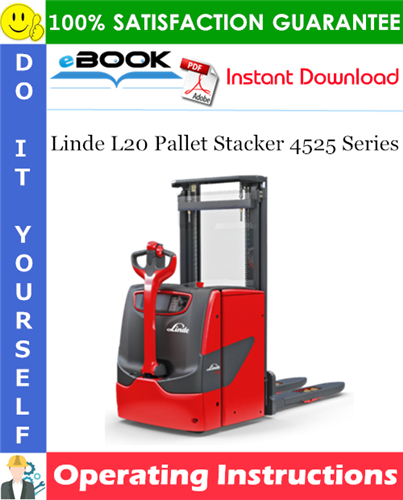This is the COMPLETE Operating Instructions Manual for the Linde Pallet Stacker Type 4525, Models L20.
This Manual Describes Procedures for Operation, Handling, Lubrication, Maintenance, Checking, and Adjustment. it will help the operator or anyone Realize Peak Performance Through Effective, Economical and Safe Machine Operation and Maintenance.
Covered models:
L20
Operating Instructions Manual Contains:
=========
CHAPTER 1
1.1 – INTRODUCTION
1.1.a- General description
1.1.b- Customer service department
1.1.c- Spare parts
1.1.d- Warranty card
1.1.e- How to use the manual
1.2 – REFERENCED STANDARDS
1.3 – AREAS WITH THE RISK OF EXPLOSION
1.4 – TYPE OF USE AND INSTRUCTIONS FOR USE
1.5 – USAGE PROHIBITIONS
1.6 – DESCRIPTION OF THE TRUCK
1.6.a- Fastening attachments
1.6.b- Modifications to the truck
1.7 – TRUCK DELIVERY
CHAPTER 2 Safety
2.1 – SAFETY INSTRUCTIONS.
2.1.a- General safety instructions
2.1.b- Flooring requirements
2.1.c- Safety instructions for operating the truck
2.1.d- Safety instructions for supplies
2.2 – LOCATION OF THE WARNING LABELS.
2.2.a- Description of the plates
2.3 – SAFETY DEVICES.
CHAPTER 3. Technical data – Identification of the truck
3.1 – L20-L20i DIMENSIONS
3.2 – SPECIFICATIONS FOR TRUCK TYPES WITHOUT INITIAL ARM LIFT FUNCTION AND A CARRYING CAPACITY OF 2000 KG
3.3 – SPECIFICATIONS FOR TRUCK TYPES WITH INITIAL ARM LIFT FUNCTION AND A CARRYING CAPACITY OF 2000 KG
3.4 – L20 AS DIMENSIONS
3.5 – L20 AS SPECIFICATIONS
3.6 – L20-L20i MAST TYPES
3.7 – L20 AS MAST TYPES
3.8 – BATTERY SIZES AND WEIGHTS
3.8.a- For the version without the initial frame members lift function
3.8.b- For the version with the initial frame members lift function
3.9 – NOISE
3.10 – VIBRATIONS
3.11 – IDENTIFICATION OF THE TRUCK.
3.11.a- Location of the labels
3.11.b- Truck identification plate
3.11.c- Carryng capacity plate
3.12 – TRANSPORTING AND LIFTING THE TRUCK
3.12.a- Transporting the truck
3.12.b- Climatic conditions for transporting and storing the truck
3.12.c- Loading and unloading the truck
CHAPTER 4. Learning about the truck
4.1 – OVERALL VIEWS
4.1.a- Overall view (for truck type without initial arm lift function)
4.1.b- Overall view (for truck type with initial arm lift function)
4.2 – DEFINITION OF THE DIRECTION OF TRAVEL
4.3 – INSTRUMENTS AND CONTROLS
4.3.a – Tiller controls (for the truck type without the initial frame members lift function)
4.3.b- Tiller controls (for truck type with the initial arm lift function)
4.3.c – Tiller positions
4.4 – CONTROL PANEL
4.4.a- Emergency stop button
4.4.b- Start/stop switch
4.4.c- Battery status indicator and hour counter
4.5 – ACCESS TO THE INSIDE
CHAPTER 5. Using the truck
5.1 – DAILY CHECKS BEFORE USE.
5.2 – USING THE TRUCK
5.2.a- Position of the operator
5.2.b- Uses for truck versions with initial arm lift function
5.2.c- Starting the truck
5.2.d- Traveling
5.2.e- Using the truck with the “tiller always enabled” function
5.2.f – Reversing the direction of travel
5.2.g- Stopping the truck
5.2.h- Stopping the truck in an EMERGENCY
5.2.i – Stopping the truck for a long period
5.3 – ENGAGING AND DISENGAGING THE LOAD
5.3.a- Fork lift function
5.3.b- Fork lower function
5.3.c- Arm lift function
5.3.d- Arm lower function
5.3.e- Towing the load
5.3.f – Towing the truck
5.4 – CHARGING THE BATTERY BY MEANS OF EXTERNAL BATTERY CHARGER.
5.5 – BATTERY CHARGE BY THE BATTERY-CHARGER ON BOARD (if equipped)
5.6 – USE OF THE TRUCK WITH EXTENSION CORDS
5.7 – USING THE “COLD STORAGE” TRUCK
5.8 – RUNNING IN THE TRUCK
5.9 – MALFUNCTIONS – CAUSES – REMEDIES
CHAPTER 6. Maintenance
6.1 – MAINTENANCE OPERATIONS
6.1.a- Preliminary maintenance operations
6.2 – MAINTENANCE AS REQUIRED
6.2.a- Cleaning the truck
6.2.b- Replacing the battery (for the version without the initial frame members lift function)
6.2.c- Replacing the battery (for the version with the intial frame members lift function)
6.2.d- Rack with rollers for the side removal of the battery (If present)
6.2.e- Disassembling the hoods
6.2.f – Replacing the fuses
6.2.g- Replacing the drive wheel
6.2.h- Replacement / Adjustment of the pivoting wheels
6.3 – SCHEDULED MAINTENANCE
6.3.a- Overview table of maintenance operations
6.3.b- Checking the tightness of the wheels
6.3.c- Checking the wear and tear of the wheels
6.3.d- Checking the level and density of the electrolyte
6.3.e- Lubricating the slide-track of the forks (only if the truck is equipped with movable forks)
6.3.f – Checking the level of hydraulic oil
6.3.g- Greasing the mast
6.3.h- Cleaning and greasing the chains
6.4 – SUPPLIES TABLE
CHAPTER 7. Out of service
7.1 – GENERAL DESCRIPTION
7.1.a- Temporarily out of service
7.1.b- Checks and inspections after a long period of inactivity
7.1.c- Permanently out of service (Scrap)
7.1.d- Disposing of toxic substances
=========
** Model Specification: Linde L20 Pallet Stacker 4525 Series
** Language: English
** Total Pages: 156
** File Format: PDF
** Requirements: Adobe PDF Reader
** Compatible: All Versions of Windows & Mac, Linux OS, Iphone, Ipad, Android etc…
=========
This QUALITY manual is 100 percents COMPLETE and INTACT,
no MISSING/CORRUPT pages/sections to freak you out! It also is Bookmarked and SEARCHABLE to make what you need easy to find. Complete download comes in PDF format which can work under all PC based Windows operating system and Mac also. It saves to your hard-drive and can be burned to CD-ROM. It can be viewed on any computer, as well as zoomed and printed.
This manual is INSTANT DOWNLOAD. It means no shipping cost or waiting for a CD / paper manual to Arrive in the Mail. You Will receive this Manual today via Instant Download on Completion of Payment via our secure Payment Processor. We Accept All Major Credit/Debit Cards and Paypal. Buy From us and I Guarantee You’ll be a Satisfied Customer and Contact us if You have any Questions.
After your payment is submitted, The Download Link will appear at the checkout page and it will also be sent to your E-Mail Address.
Thanks for Visiting!
